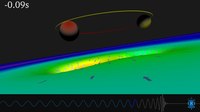
Photo from wikipedia
The problem of data-driven joint design of transmitted waveform and detector in a radar system is addressed in this article. We propose two novel learning-based approaches to waveform and detector… Click to show full abstract
The problem of data-driven joint design of transmitted waveform and detector in a radar system is addressed in this article. We propose two novel learning-based approaches to waveform and detector design based on end-to-end training of the radar system. The first approach consists of alternating supervised training of the detector for a fixed waveform and reinforcement learning of the transmitter for a fixed detector. In the second approach, the transmitter and the detector are trained simultaneously. Various operational waveform constraints, such as peak-to-average-power ratio and spectral compatibility, are incorporated into the design. Unlike traditional radar design methods that rely on rigid mathematical models, it is shown that radar learning can be robustified to uncertainties about environment by training the detector with synthetic data generated from multiple statistical models of the environment. Theoretical considerations and results show that the proposed methods are capable of adapting the transmitted waveform to environmental conditions while satisfying design constraints.
Journal Title: IEEE Transactions on Aerospace and Electronic Systems
Year Published: 2022
Link to full text (if available)
Share on Social Media: Sign Up to like & get
recommendations!